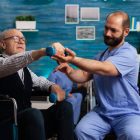Synopsis
Chronic lower back discomfort can severely impact daily life, making the search for effective intervention paramount. This comprehensive guide outlines the critical role of physio for back pain in addressing the deep-seated causes of discomfort. We will explore how a targeted physical therapy treatment for back pain program, overseen by certified specialists, can offer lasting relief and functional recovery. For those suffering from a pervasive physio for sore back, this resource provides insight into non-invasive methods that bypass reliance on medication or surgical routes. The journey to recovery often begins with an accurate diagnosis, followed by a customized approach that incorporates mobilization, strengthening, and posture correction. Importantly, we also detail the necessary rehabilitation steps involved in physiotherapy for lower back pain, ensuring a safe and complete return to activity. This article is vital for anyone considering advanced back pain physical therapy treatment, especially in cases requiring post-operative recovery, where structured physiotherapy after surgery is indispensable. Our aim is to demystify the process and highlight the benefits of a structured, specialized approach to spine health. Whether you are dealing with acute discomfort or long-term chronic issues, understanding the nuances of a dedicated physio for back pain plan, including specialized physiotherapy for lower back pain techniques, will empower you to make informed decisions about your spinal health journey. A strategic physical therapy treatment for back pain is designed not just for immediate relief but for long-term functional recovery. Consult a specialist if you need professional guidance for a persistent physio for sore back and to learn about essential recovery protocols, particularly for individuals undergoing or planning to undergo physiotherapy after surgery. This proactive approach to spinal well-being, utilizing advanced techniques in back pain physical therapy treatment and a consistent physio for back pain regimen, is the key to unlocking a pain-free future. Effective physiotherapy after surgery ensures that patients recover strength and mobility quickly, moving past the acute phase of being a physio for sore back recipient and fully benefiting from a comprehensive physical therapy treatment for back pain plan, allowing them to finally overcome chronic physiotherapy for lower back pain symptoms.
Table of Contents
- The Escalating Global Challenge of Back Pain
- Understanding the Core Principles of Spinal Rehabilitation
- Diagnostic Accuracy- The First Step in Effective Treatment
- Customized Techniques in Physical Therapy
- The Critical Role of Strengthening and Posture Correction
- Navigating Recovery with Post-Surgical Physiotherapy
- Why Specialised Care is Essential for Your Back Health
- The Orthocure Advantage- Integrated, Protocol-Driven Care
- A Partner in Your Journey to Pain-Free Living
The Escalating Global Challenge of Back Pain
Back pain, particularly discomfort localized in the lower region, has reached epidemic proportions in the modern era, becoming one of the primary reasons for reduced productivity and medical consultations worldwide. The fundamental shift toward sedentary lifestyles, coupled with prolonged hours spent in ergonomically poor positions, has fundamentally compromised the natural support structures of the spine. Ignoring initial signs of stiffness or a persistent physio for sore back can lead to a cascade of complications, escalating into chronic conditions that severely restrict mobility and quality of life. This escalating challenge demands a strategic, non-pharmacological, and non-invasive solution that addresses the root biomechanical and muscular imbalances, a solution comprehensively provided by specialized physical therapy protocols. These targeted interventions move beyond symptomatic relief to deliver structural correction and long-term functional restoration, proving indispensable for those navigating the daily struggle of spinal discomfort. Finding reliable, effective physio for back pain is therefore not merely about treating a symptom but investing in the long-term integrity and health of one’s spine, especially since chronic discomfort drastically diminishes overall wellness. The contemporary approach must emphasize patient education and proactive self-management to sustain the benefits achieved through clinical sessions and prevent dependence on cyclical, palliative care methods.
Understanding the Core Principles of Spinal Rehabilitation
The philosophy behind effective spinal rehabilitation centres on a highly personalized approach, acknowledging that no two instances of discomfort are exactly alike. It requires a meticulous, structured program of physical therapy treatment for back pain that is developed by a specialist who considers the patient’s lifestyle, medical history, and specific pathology with meticulous care. The goal is to systematically break the cycle of deconditioning, where pain leads to inactivity, which in turn leads to muscle atrophy and increased pain sensitivity. This process involves gentle mobilization to restore range of motion, followed by targeted exercises designed to re-engage and strengthen the deep core musculature responsible for spinal stability and support. By focusing on normalized movement patterns and proper joint mechanics, expert physiotherapy for lower back pain aims to offload stressed discs, joints, and ligaments effectively. This therapeutic process is a deliberate journey from acute discomfort to enduring resilience, positioning physical therapy as the cornerstone of conservative spinal care. The efficacy of this structured physical therapy treatment for back pain far exceeds generic exercise routines, ensuring that every movement contributes directly to the healing and strengthening process.
Diagnostic Accuracy- The First Step in Effective Treatment
Before any therapeutic intervention can begin, a precise and comprehensive diagnosis is paramount, as a flawed initial assessment invariably leads to a misguided and ultimately ineffective treatment plan. It is insufficient to rely solely on static imaging studies like X-rays or MRIs, which often fail to capture dynamic biomechanical issues such as muscle imbalances or faulty movement patterns—the true sources of many chronic issues. A qualified physio for back pain employs an advanced diagnostic protocol that includes detailed manual testing, functional movement screens, and specialized strength assessments to pinpoint the exact contributing factors. This diagnostic phase focuses on analyzing the entire kinetic chain, understanding how issues in the feet, hips, or neck can manifest as symptoms in the lumbar region, demanding comprehensive physiotherapy for lower back pain . Once the root cause is accurately identified, whether it is a disc herniation, spinal stenosis, or muscular strain, the practitioner can initiate a truly effective and targeted back pain physical therapy treatment . This commitment to diagnostic depth ensures that the subsequent intervention is maximally efficient and safe for the patient.
Why is a multi-modal assessment better than just an X-ray for diagnosing chronic back pain?
Customized Techniques in Physical Therapy
Specialized care employs a diverse arsenal of techniques tailored to the patient’s specific needs, transcending the use of mere heat packs and basic stretches. For intense discomfort or a chronic physio for sore back , interventions can range from advanced manual therapies, such as soft tissue releases, joint mobilizations, and modified chiropractic manipulations, to cutting-edge modalities. Techniques like spinal decompression therapy are invaluable for conditions involving nerve root compression, offering a non-surgical avenue for significant relief. Furthermore, dry needling, cupping therapy, and specialized kinesio taping can be integrated to modulate pain, reduce muscular spasm, and support injured structures during the early phases of rehabilitation. Every component of the physical therapy treatment for back pain plan is selected to synergistically promote tissue healing, reduce inflammation, and restore natural movement quality. This sophisticated, multi-pronged strategy forms the bedrock of a highly effective back pain physical therapy treatment , maximizing the patient’s potential for a swift and comprehensive recovery from a chronic physio for sore back that has resisted traditional, less specialized care.
The Critical Role of Strengthening and Posture Correction
True long-term success in spinal care depends less on initial pain relief and more on establishing enduring structural stability through targeted muscle conditioning and postural re-education. Addressing the cycle of deconditioning is critical, which means a comprehensive physiotherapy for lower back pain program must incorporate scientifically guided strength training, with an emphasis on the deep core musculature and the intricate muscles surrounding the spine. These muscles, often weakened by inactivity or compensated for by larger, less efficient muscles, must be isolated and re-trained to provide robust support for the skeletal framework. Alongside strengthening, meticulous postural correction is paramount; since sitting has become the “smoking of the new generation,” correct ergonomic habits and sustained movement awareness are integrated into the treatment plan from the outset. This dual focus on structural correction and muscle strengthening elevates the treatment from temporary relief to a durable solution, a foundational principle of superior back pain physical therapy treatment .
How does core strengthening specifically prevent the recurrence of lower back pain?
Navigating Recovery with Post-Surgical Physiotherapy
For the subset of patients whose condition necessitates surgical intervention, structured rehabilitation is not optional—it is a mandatory component of a successful outcome. Physiotherapy after surgery is a specialized phase of care that begins with careful, passive mobilization and gentle exercises designed to protect the surgical site while preventing stiffness and scar tissue formation. The early stages focus intensely on managing post-operative pain and achieving fundamental mobility milestones under strict medical guidance to ensure the integrity of the repair. As healing progresses, the program evolves into a phased return-to-activity protocol, progressively introducing strength training and functional movements, always mindful of the patient’s individual pain thresholds and surgical restrictions. The goal of this focused physiotherapy after surgery is to ensure the patient regains pre-injury levels of strength and functionality, accelerating their return to daily activities and work life, minimizing complications. A dedicated regimen of physio for back pain , tailored for post-operative needs, minimizes complications and dramatically improves the quality of life following a procedure.
What are the essential phases of physiotherapy rehabilitation following back surgery?
Why Specialised Care is Essential for Your Back Health
When dealing with the complexities of spinal health, generic healthcare approaches are often inadequate; the spine demands specialization and a multi-disciplinary perspective that can look beyond the superficial symptoms. The intricate relationship between bones, discs, nerves, and soft tissues requires a practitioner who possesses deep, focused expertise in musculoskeletal mechanics and pathology. Choosing a dedicated provider for physio for back pain ensures access to the latest, evidence-based global protocols and advanced technologies that many general practices lack. Such facilities integrate the expertise of orthopaedic doctors, chiropractors, and physiotherapists, allowing for seamless referrals and a consensus-driven approach to complex cases, eliminating reliance on a single opinion. This collaborative model guarantees that every patient receives the most appropriate treatment at every stage of their recovery, from initial diagnosis to advanced strength conditioning. Specialized physical therapy treatment for back pain ensures you are not just managed but structurally corrected, significantly reducing the likelihood of pain recurrence and safeguarding spinal longevity.
What makes a dedicated spinal clinic better than a general practitioner for chronic back pain?
The Orthocure Advantage- Integrated, Protocol-Driven Care
ORTHOCURE CLINICS AND GYMS distinguishes itself as India’s first chain of specialty clinics for orthopaedic problems by pioneering a truly integrated, protocol-driven model of care for conditions like chronic back pain and providing meticulous physiotherapy after surgery . The core strength of the brand lies in its unique 4 Point Protocol, a standardized methodology developed from associations with leading healthcare practices in the USA and Europe. This protocol ensures that whether a patient requires immediate pain relief, structural correction through modified Chiropractic techniques, or long-term conditioning via the globally acclaimed MedX, USA machines, every step is deliberate and measured. This seamless integration of orthopaedic doctors, physiotherapists, and fitness specialists ensures that patients receive a 360-degree solution—a critical offering when dealing with a complex issue like chronic physiotherapy for lower back pain . They use advanced technology, such as the Spinal Decompression Treatment from Canada, to offer non-surgical, gold-standard interventions for severe conditions like disc herniation, reflecting their commitment to bringing the best of world medical technology to India.
What is the biggest advantage of Orthocure’s integrated care model?
A Partner in Your Journey to Pain-Free Living
The services offered by ORTHOCURE CLINICS AND GYMS are comprehensive, extending well beyond episodic treatment to encompass lifelong wellness and prevention. Beyond addressing specific pain points with services like specialized physiotherapy for lower back pain , the brand offers specialized programs that align with modern lifestyle needs. The WorkFIT Program targets sedentary professionals with ergonomic and posture analysis, while the OrthoFIT/FitX40 Medical Fitness program focuses on maintaining strength and vitality, especially for the 40+ age group. The ultimate USP of ORTHOCURE CLINICS AND GYMS lies in its dedication to structural correction over temporary pain relief, using accurate diagnostics and specialized equipment to solve the problem from its origins. By combining expert manual therapy with the precision of machines like MedX, they offer a clear path to overcoming chronic discomfort, ensuring patients can confidently return to a life free from the limitations of spinal pain, backed by a high-success-rate protocol.
How does Orthocure ensure long-term wellness after treatment?
FAQs
How can a specialized physio for back pain resolve symptoms better than general exercises?
Specialized physio for back pain is vital because it begins with an in-depth diagnostic process, identifying the exact source of your discomfort, which generic exercise often misses. A qualified practitioner will assess your entire biomechanical chain, including posture and muscle imbalances, to create a truly bespoke treatment plan. This involves targeted techniques, such as spinal mobilization and soft tissue release, ensuring the therapy addresses the root cause of the issue. Furthermore, the progression of exercises is medically supervised, preventing re-injury and ensuring the correct muscles are isolated and strengthened, moving you safely past the acute phase of being a physio for sore back. This structured approach guarantees a more effective and sustainable recovery trajectory.
What key components are included in a comprehensive back pain physical therapy treatment program?
A comprehensive back pain physical therapy treatment program is typically multi-modal, starting with initial pain-relieving strategies using advanced modalities to calm a persistent physio for sore back. Following this, the core focus shifts to structural correction, involving manual therapy to restore joint mobility and correct spinal alignment. Essential to the program is therapeutic exercise designed to strengthen the deep core and stabilizing muscles, which is critical for preventing recurrence and managing chronic physio for back ache. Finally, patient education is a major component, equipping you with the ergonomic and postural knowledge needed for self-management and long-term spinal health maintenance. This holistic strategy is what differentiates effective physical therapy treatment for back pain from temporary fixes.
How does a patient benefit from having structured physiotherapy after surgery for a spinal condition?
Structured physiotherapy after surgery is non-negotiable for a successful post-operative outcome, as it controls the rate of recovery and minimizes long-term complications. The therapist guides you through a graded rehabilitation program that protects the surgical site while systematically preventing stiffness and regaining lost strength and mobility. Early intervention includes gentle passive mobilization to maintain joint health, while later phases focus on core and spinal stability to safely return to daily activities and prevent undue stress on the healed structures. This specialized program ensures that the patient fully benefits from the surgery by achieving the best possible functional capacity, and it significantly accelerates the journey from a patient needing specialized physiotherapy for lower back pain to one enjoying full function.
Can physiotherapy for lower back pain offer a permanent solution to chronic discomfort?
Yes, physiotherapy for lower back pain aims for a permanent solution by focusing on structural correction and functional independence, unlike medications which only mask symptoms. A skilled practitioner will delve into the underlying causes—be it poor posture, muscle weakness, or joint stiffness—and use targeted mobilization and specialized strengthening exercises to resolve them. This approach breaks the debilitating cycle of pain, weakness, and recurring physio for back ache. By incorporating elements of preventative care, the treatment empowers the patient with the tools and strength needed to manage their spine health for the long term, making it the most effective long-term physical therapy treatment for back pain available.
What evidence-based techniques are used in physical therapy treatment for back pain to address chronic physio for back ache?
Evidence-based physical therapy treatment for back pain for chronic physio for back ache typically employs advanced manual therapy, such as soft tissue manipulation and joint mobilization, to reduce tension and restore natural movement. Modalities like spinal decompression or therapeutic ultrasound may be used to manage persistent discomfort. The cornerstone is a progressive strengthening program focused on the deep stabilizing muscles, often utilizing specialized, medically supervised equipment to ensure precision and safety, preventing the condition from reverting to a physio for sore back. This comprehensive, protocol-driven approach ensures that post-surgical recovery is robust, integrating seamlessly with any necessary physiotherapy after surgery.





